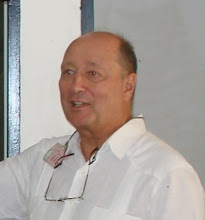During the earthquake of 12 January, many people suffered crushing injuries to their extremities; primary care for the injured often required amputations of injured or infected limbs. An estimated 2-4,000 amputatins were performed in the first week after the earthquake, many of them under rudimentary field conditions.
Patients who arrived at HAS with crushing injuries to the extremities were managed by a specialized nursing wound care team, and the surgeons were very conservative in their management of these cases, exercising limb salvage strategies to the greatest extent possible. Only 15 long-bone amputations were required for the patients at HAS, but soon after the earthquake, we began to receive referrals from other hospitals for patients who required revisins of thei original amputaions.
Soon after the earthquake, at the encouragement of the Peachtree Orthopedic Group, which had sent two teams to HAS, we received a visit from Harold Anderson, an amputee, who brought with in representatives of the Hanger Corporation (a national leader in prosthetics and orthotics), and of the Shepherd Rehabilitation Hospital in Atlanta. This group offered to HAS the opportunity to establish a prosthetics laboratory on a turnkey basis, in order to address a national demand in Haiti. Both opf the prosthetics services in Port au Prince were taken out of service as a result of the quake, and the demand for artificial limbs was becoming more apparent daily.
 Technicians from the Hanger group arrived with several pallets of equipment and supplies, and set up an operating laboratory in three days. Yesterday three of the 8 patients currently housed at HAS l'Escale village were fitted with new legs and given the opportunity to try them out. Ania, shown in this picture, is a teenager with a beguiling smile and a doting father, the only surviving members of their family. She has made firm friendships with other young patients in the village, where they assist each other to accommodate to their physical losses with a strengthening of emotional bonds and mutual support.
Technicians from the Hanger group arrived with several pallets of equipment and supplies, and set up an operating laboratory in three days. Yesterday three of the 8 patients currently housed at HAS l'Escale village were fitted with new legs and given the opportunity to try them out. Ania, shown in this picture, is a teenager with a beguiling smile and a doting father, the only surviving members of their family. She has made firm friendships with other young patients in the village, where they assist each other to accommodate to their physical losses with a strengthening of emotional bonds and mutual support. Ania's first steps were difficult, but she kept at it for almost a half-hour, wanting to master the new technique of walking with an unfamiliar appendage. Perseverance, the watchword of the Haitian people, is never more evident than in the new prosthetics facility.
For HAS, this also represents.new steps; starting from a commitment in 2007 to develop a training program for Rehabilitation Technicians, which has been supported by the Friends of HAS, and which is guided by Health Volunteers Overseas. The 2009 class graduated three students, one of whom is in the hospital, and the other two of whom are assigned to the dispensaries. The current class has six students, who arrived a week before the earthquake. A full-time Haitian PT (a rare commodity in Haiti) has been added to the staff, thanks to support from the Friends. Now, with the arrival of the Prosthetics lab, HAS is emerging into a new clinical arena, and also in a new role within Haiti. All of the current patients are victims of the Port au Prince earthquake, and have been cared for by HAS and several PIH-related facilities in Cange and St. Marc. Additional patients are awaiting transfer to HAS in the near future.
HAS was honored by the selection of Shaun Cleaver, the Canadian PT who started the Rehabilitation Technician training program, as a member of the national council which is charged with developing policies for the care of persons with disabilities, and specifically for the provision of resources to support persons with amputations. This places HAS in the center of planing for one aspect of medical care in Haiti, which in the future will of necessity be more decentralized away from the devastation in the capital. Parallel planning processes will be developed for the acute health care system as well, and the HAS experience will contribute to those plans.
Ian Rawson



